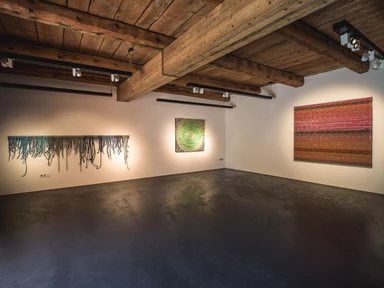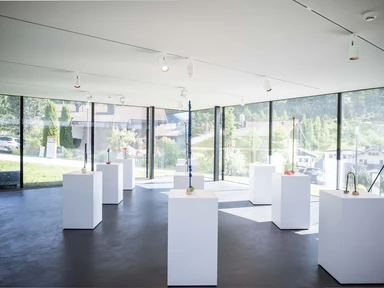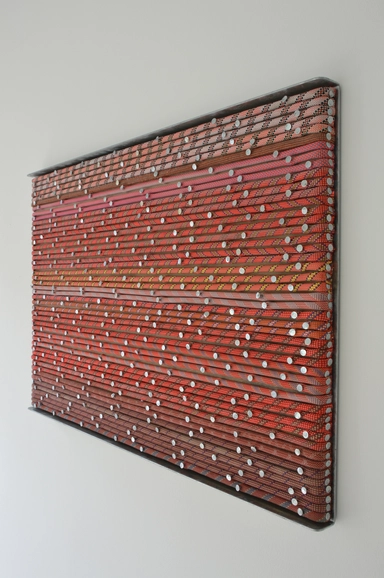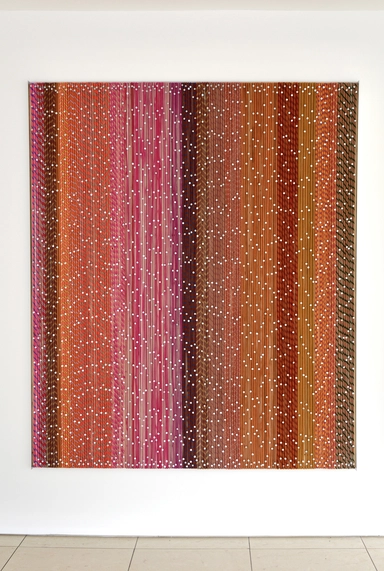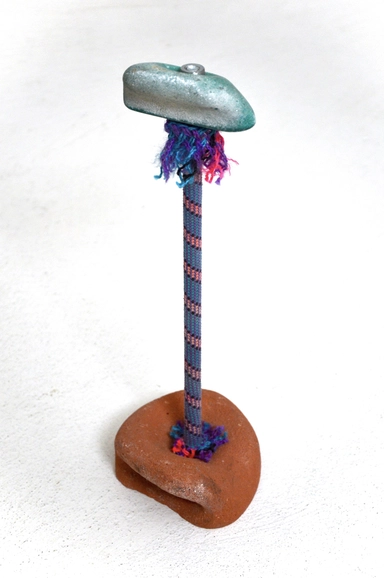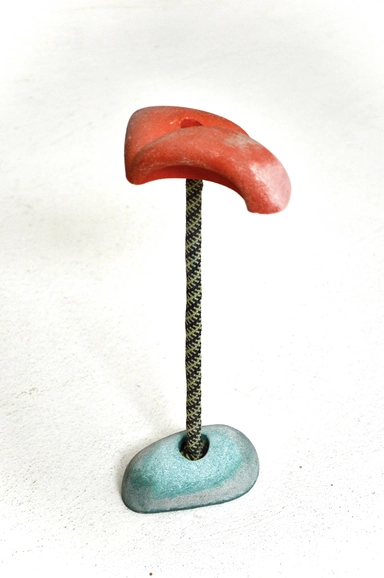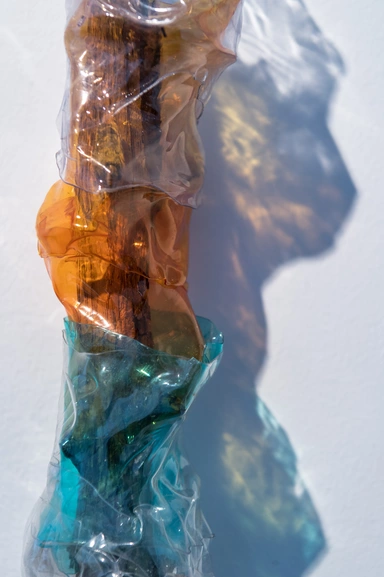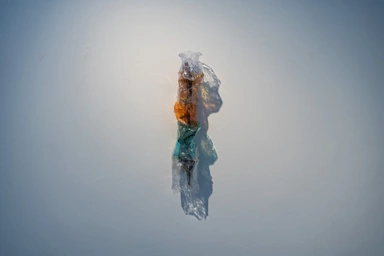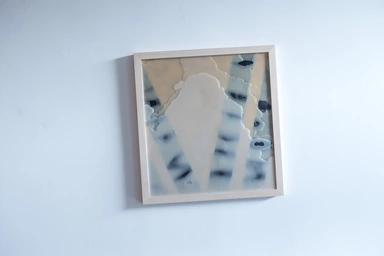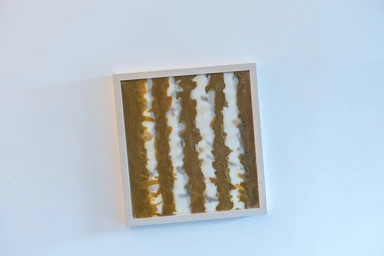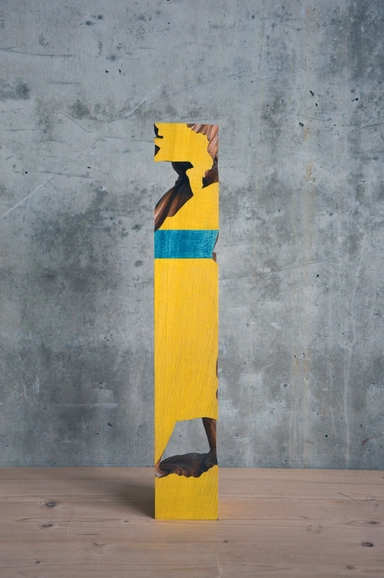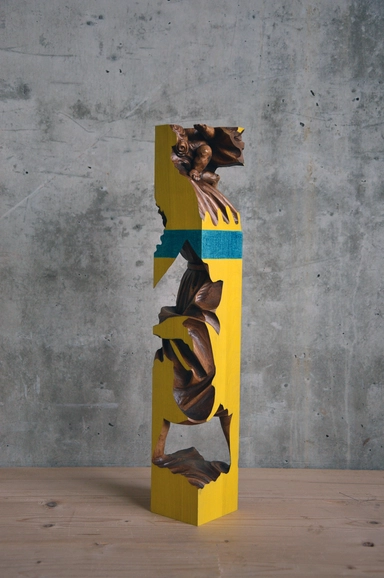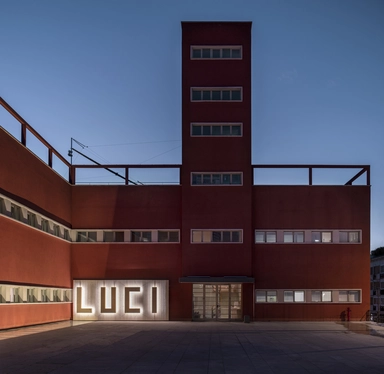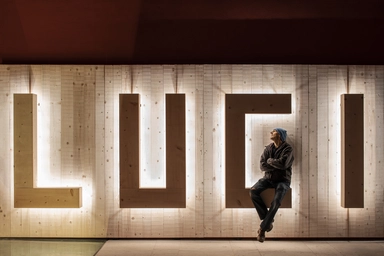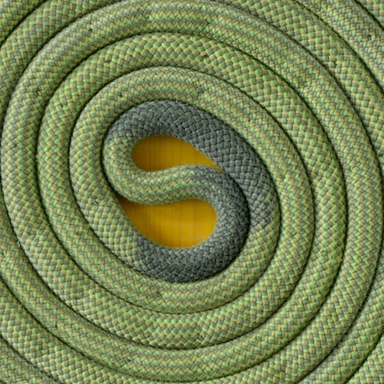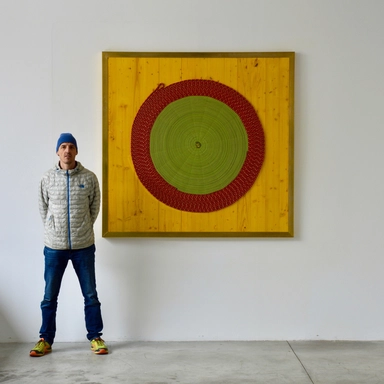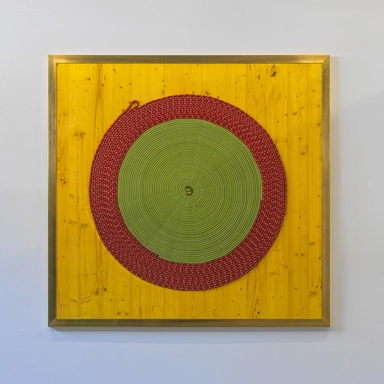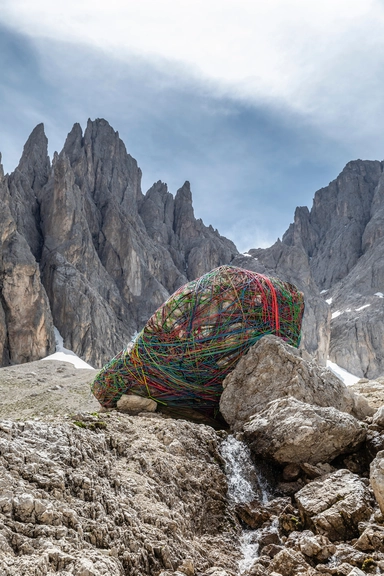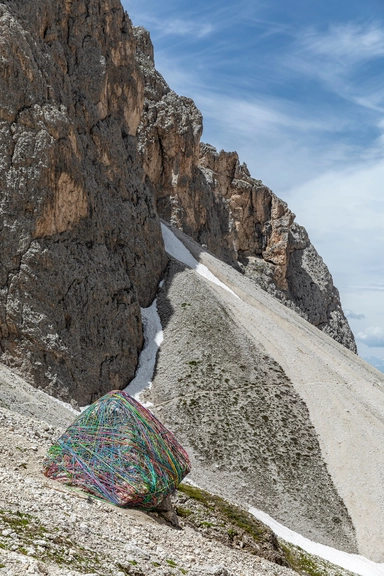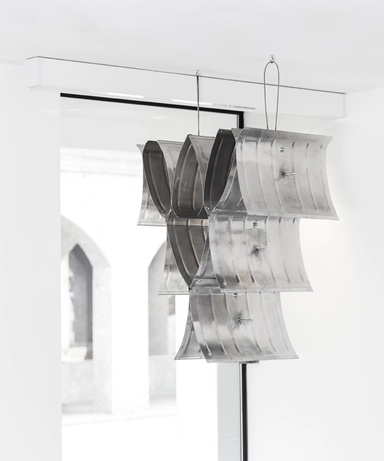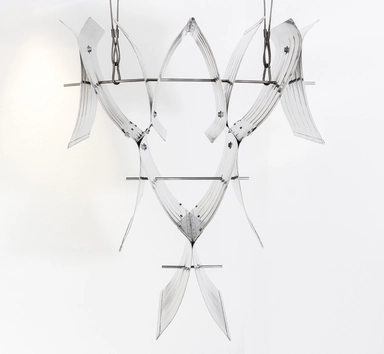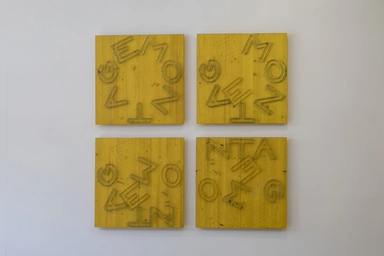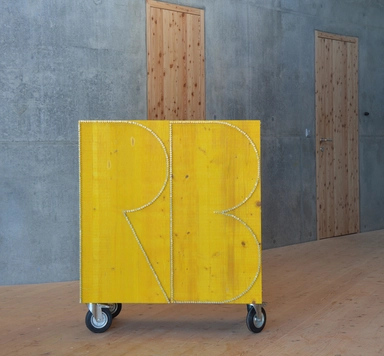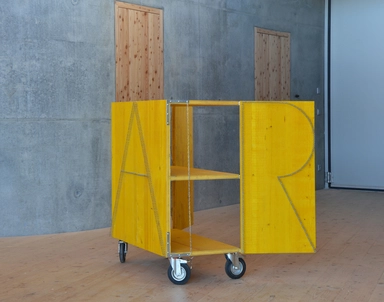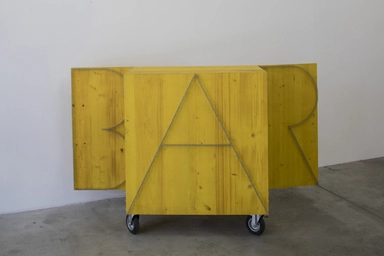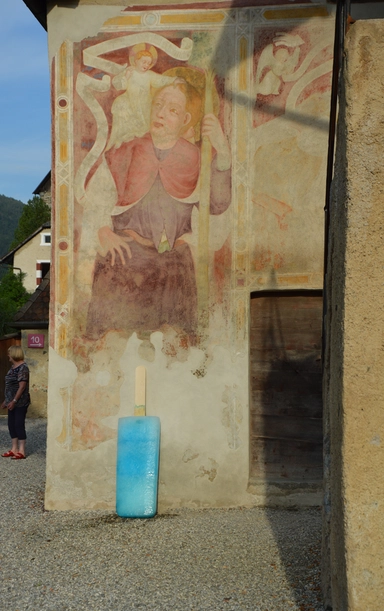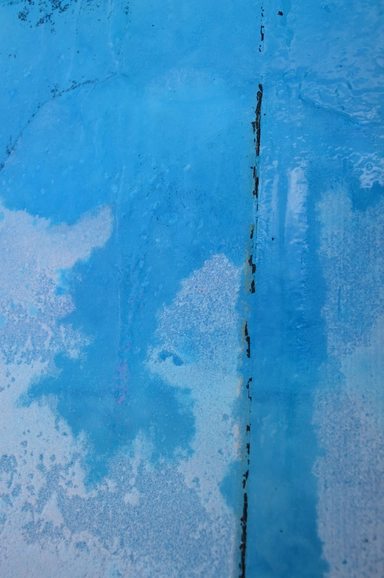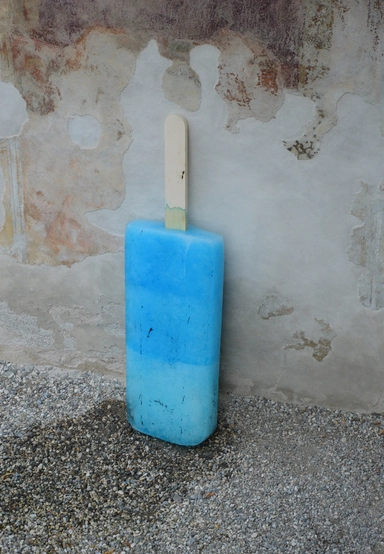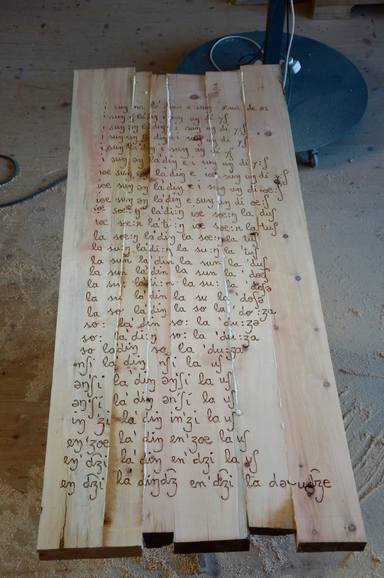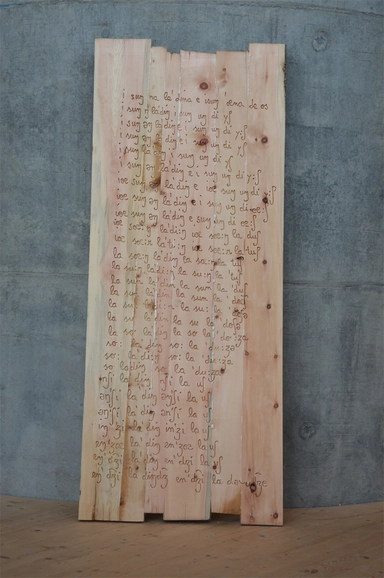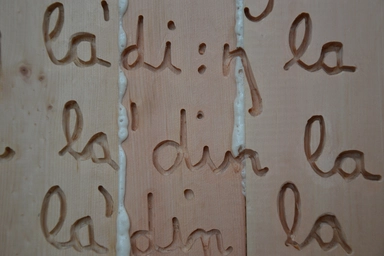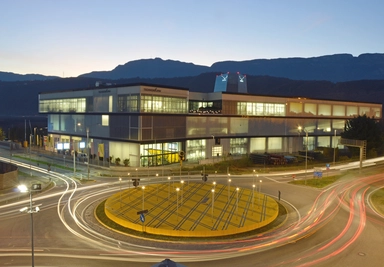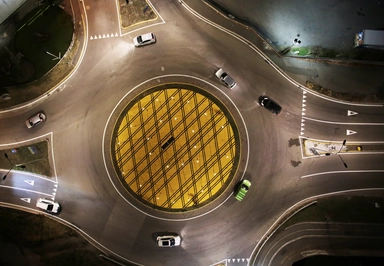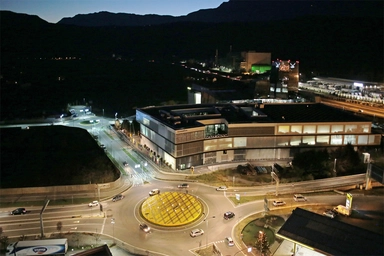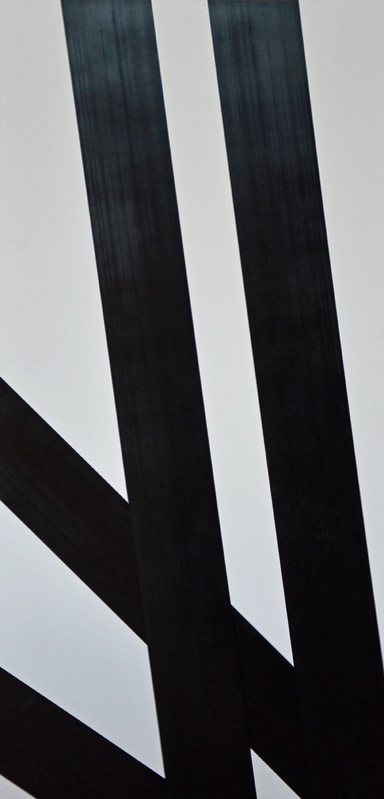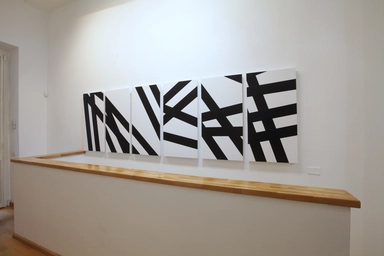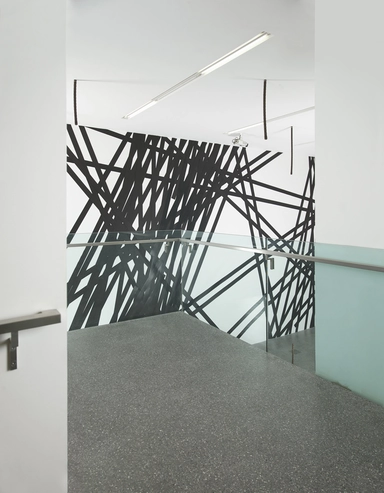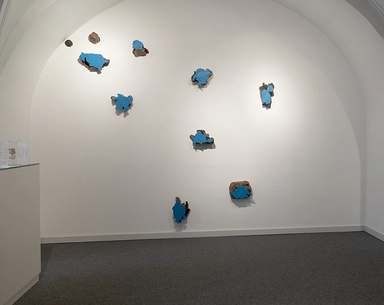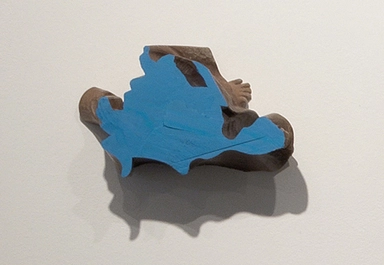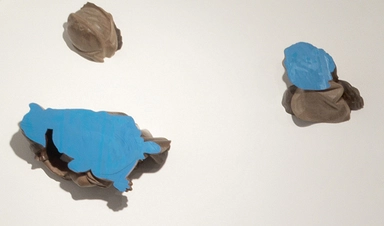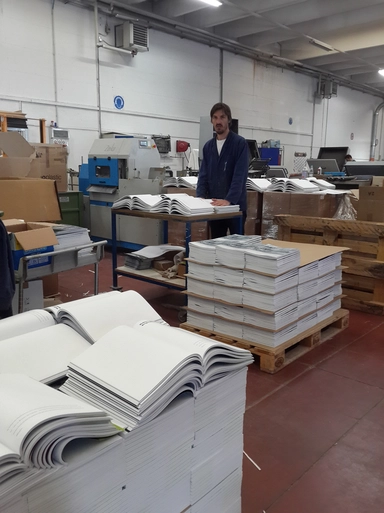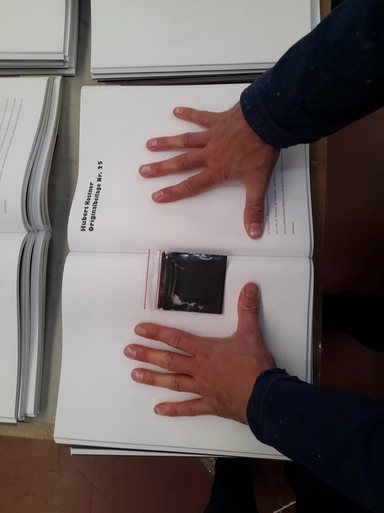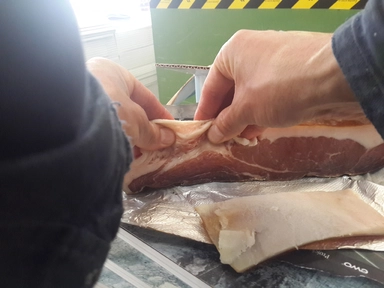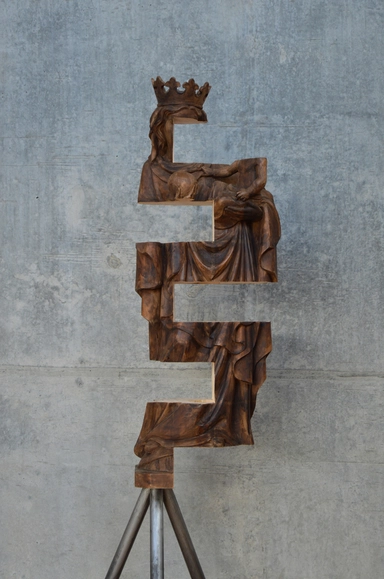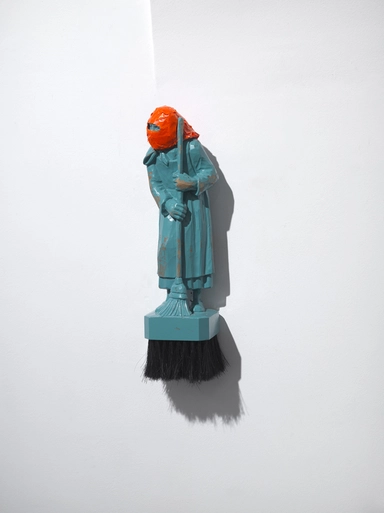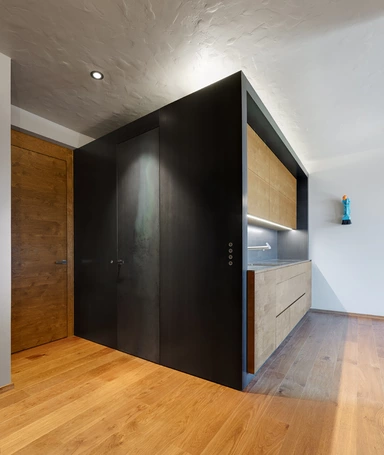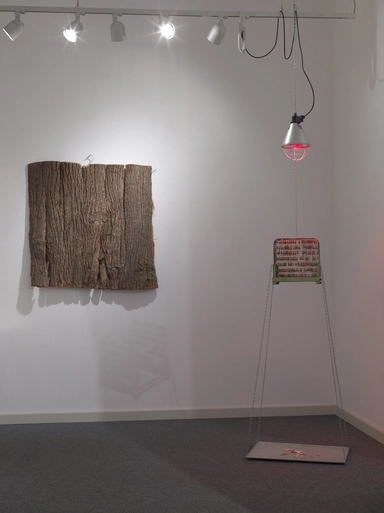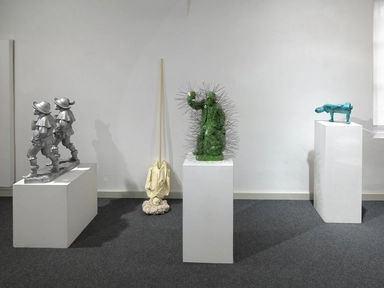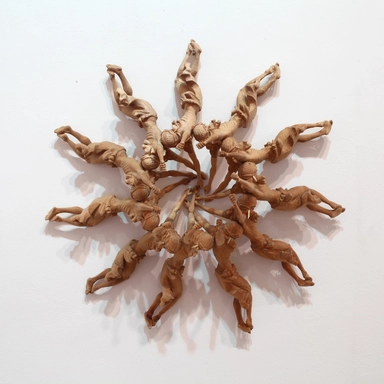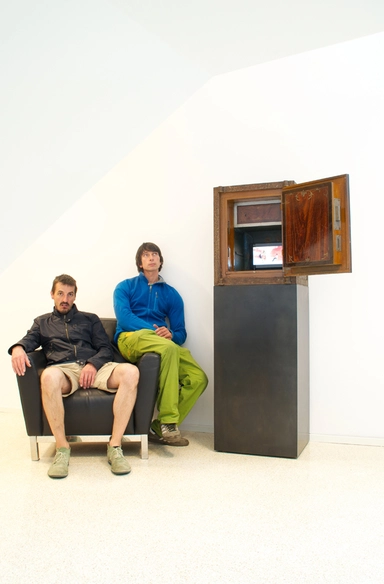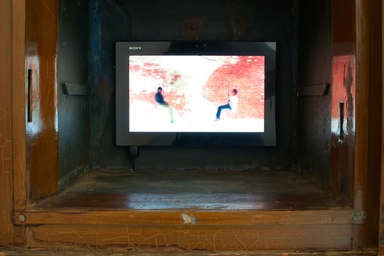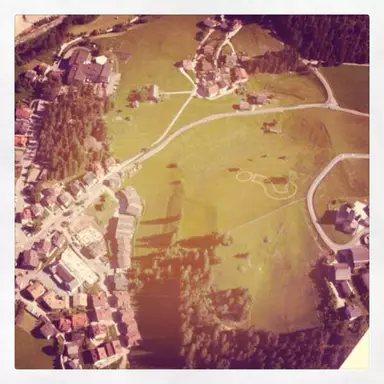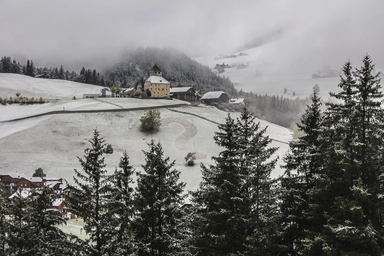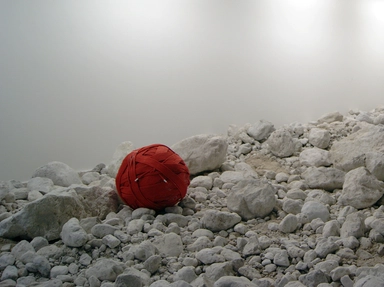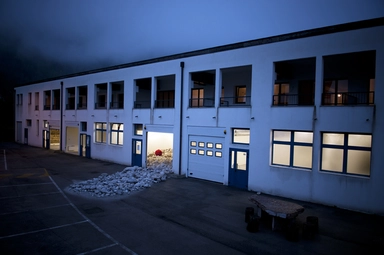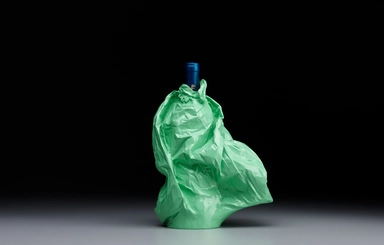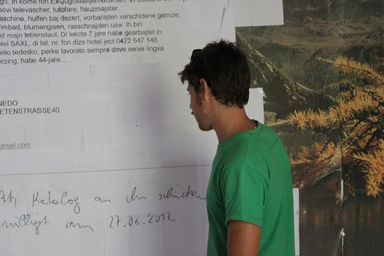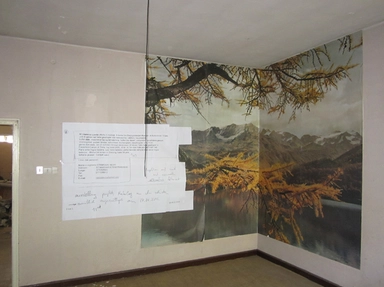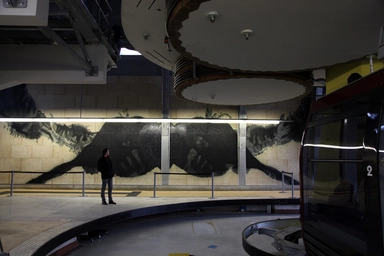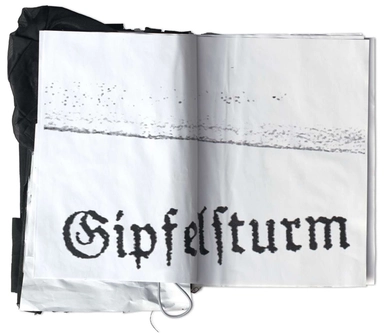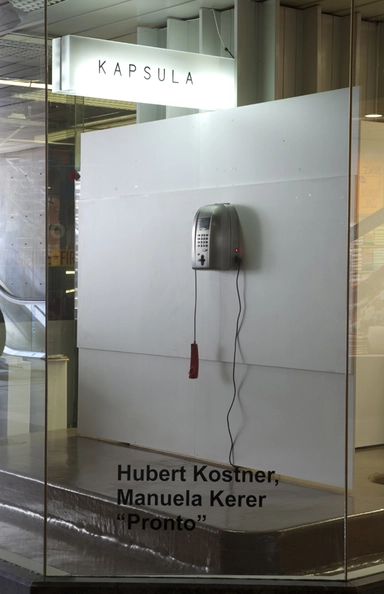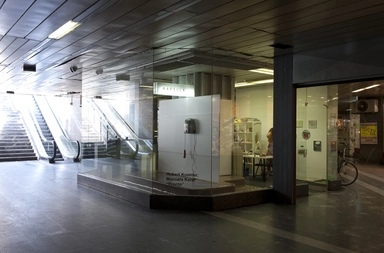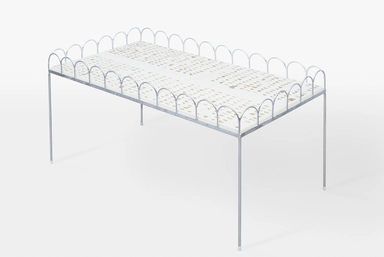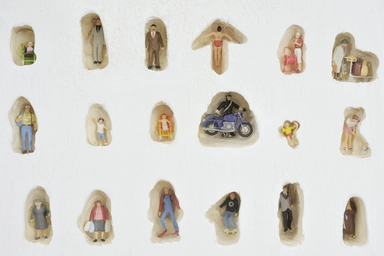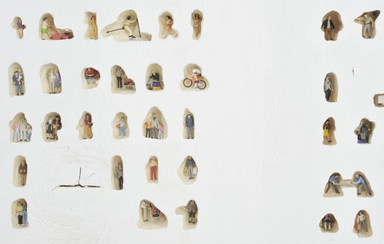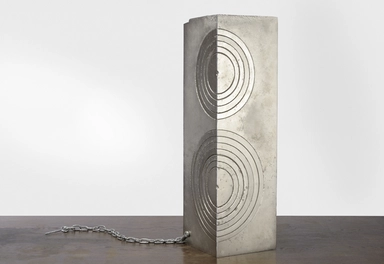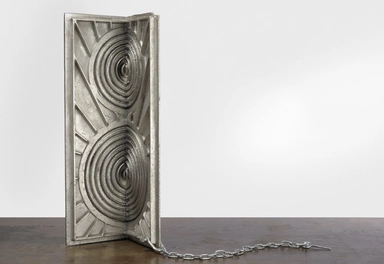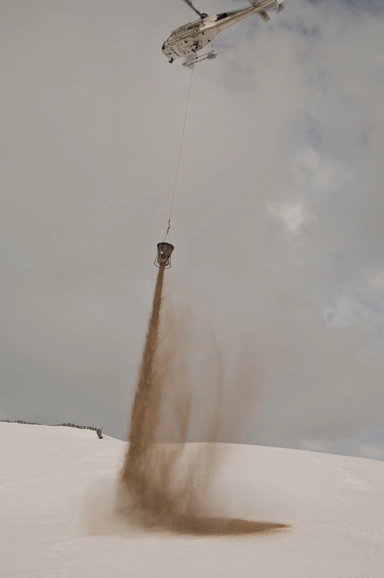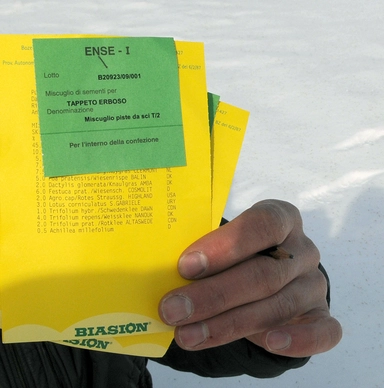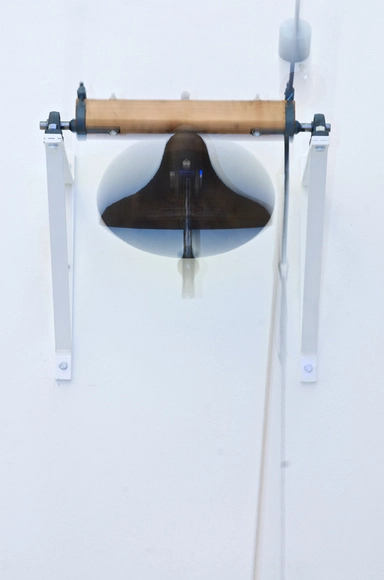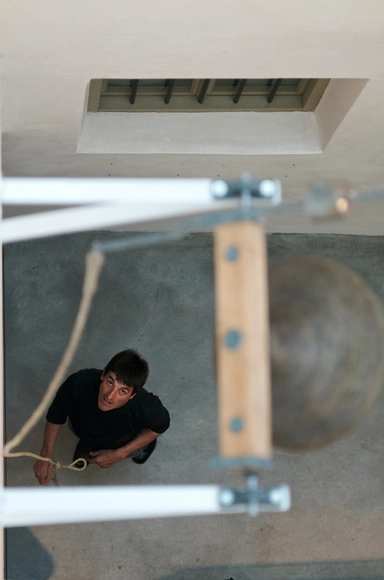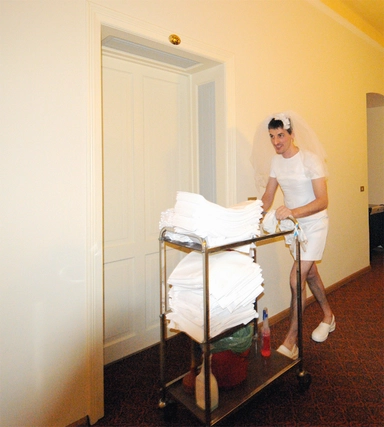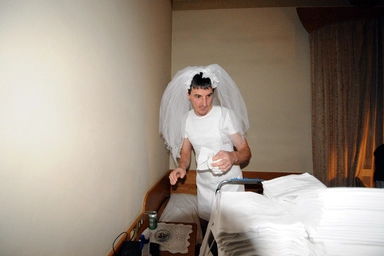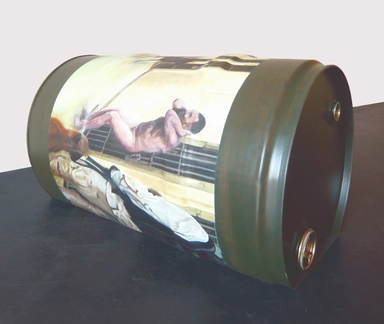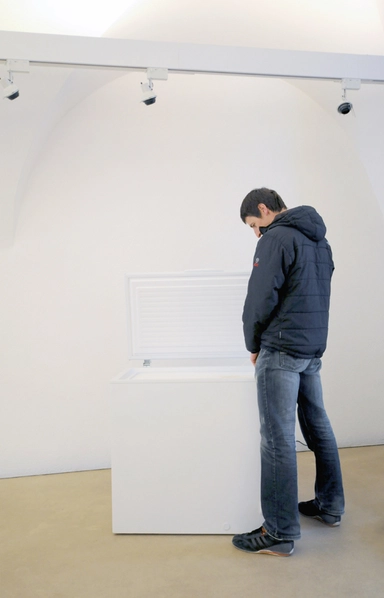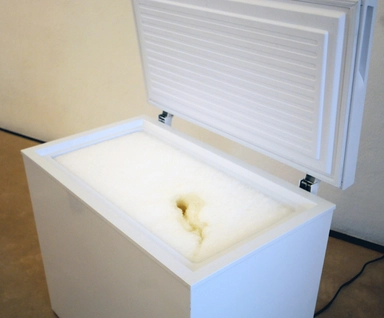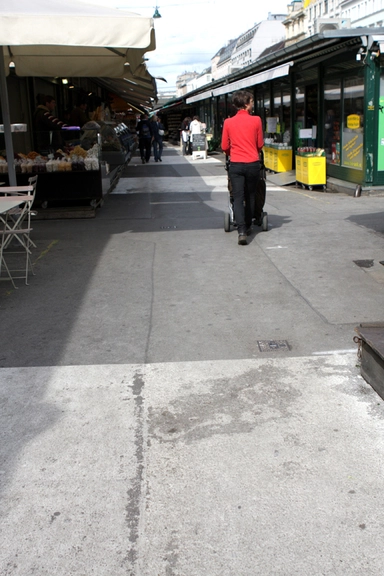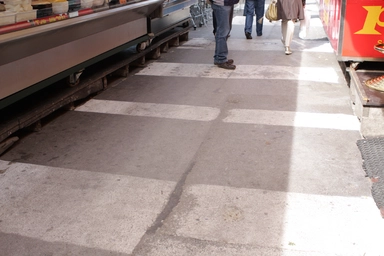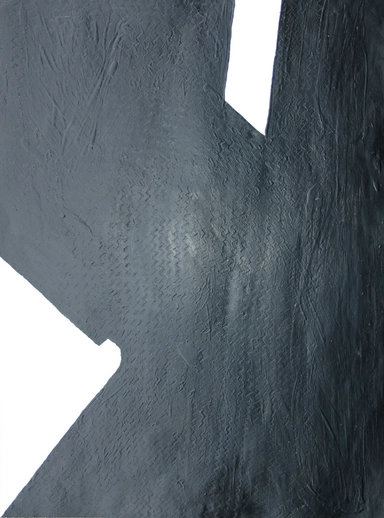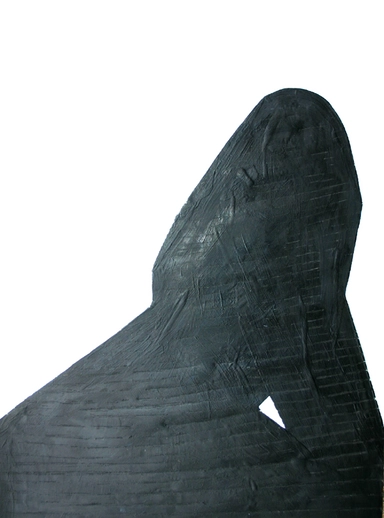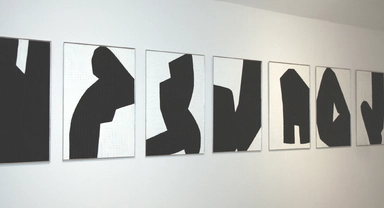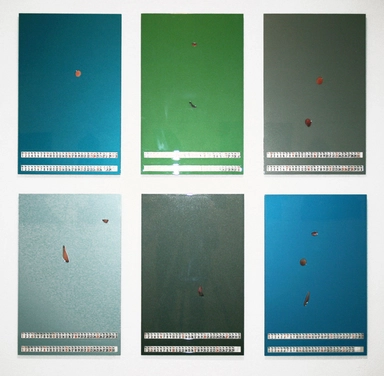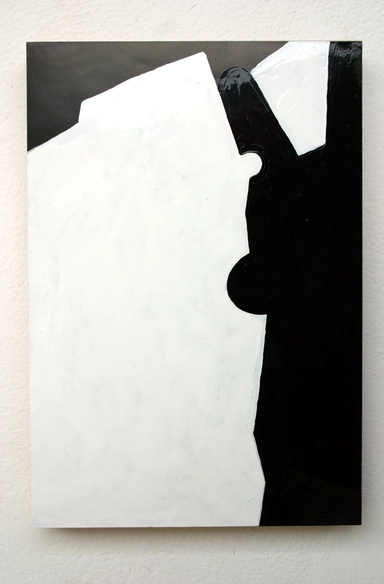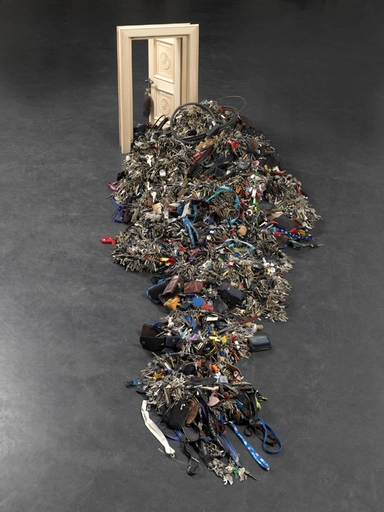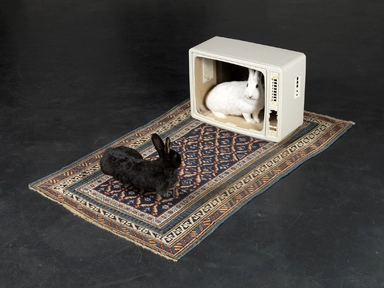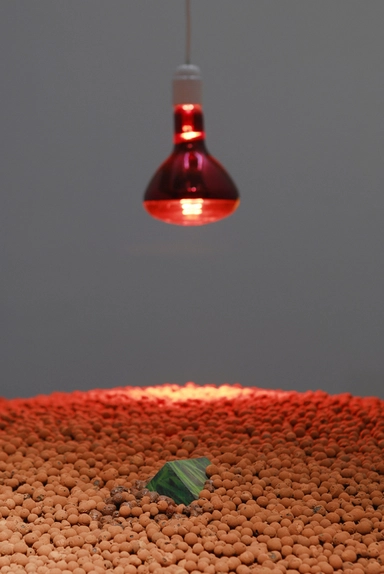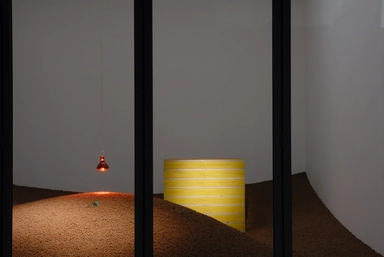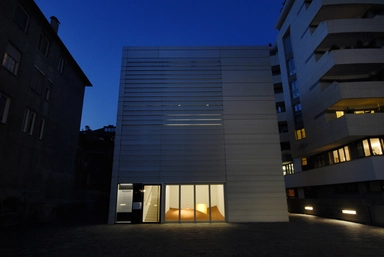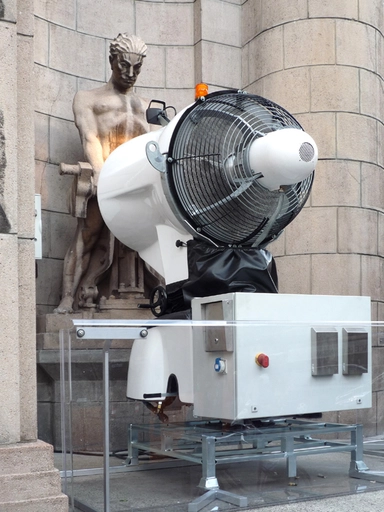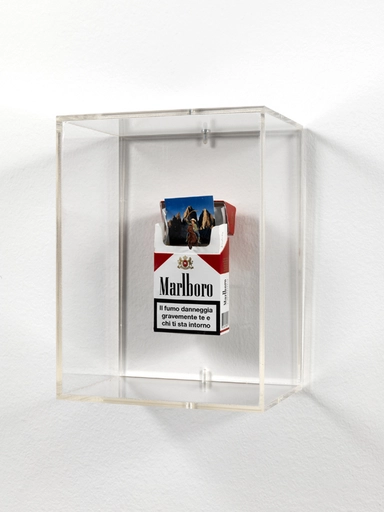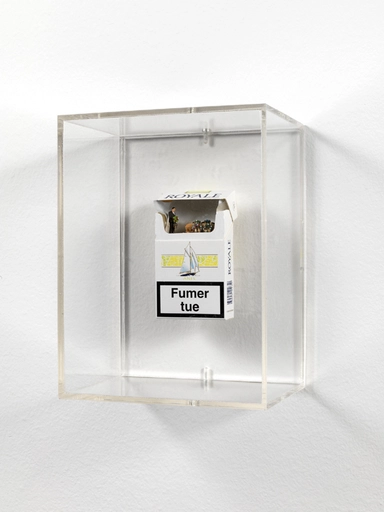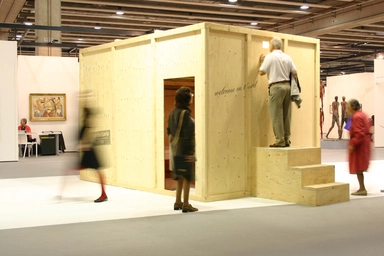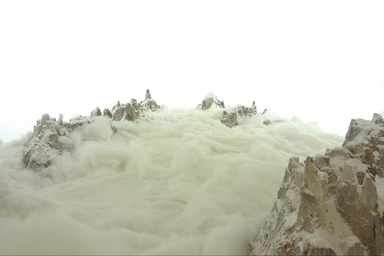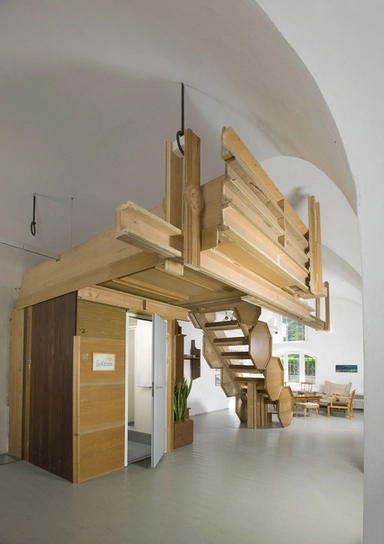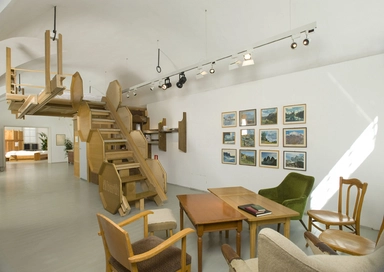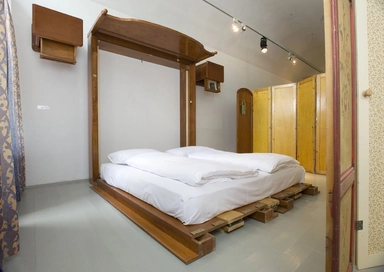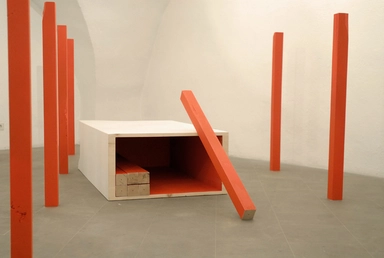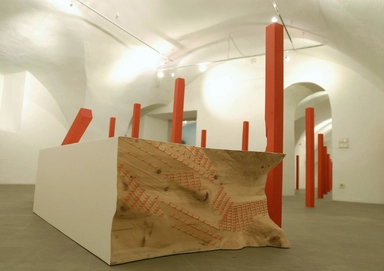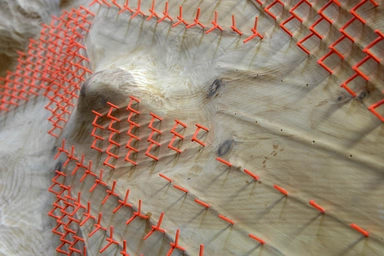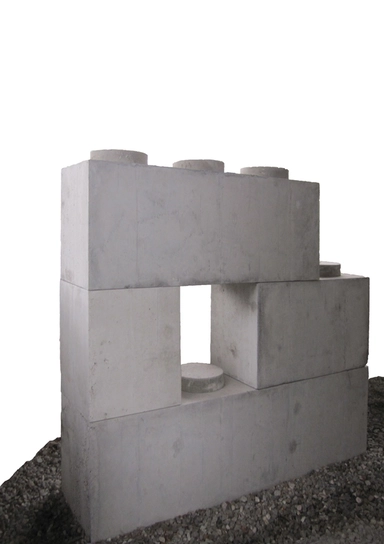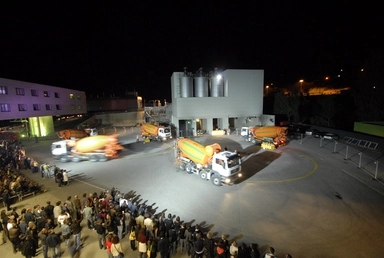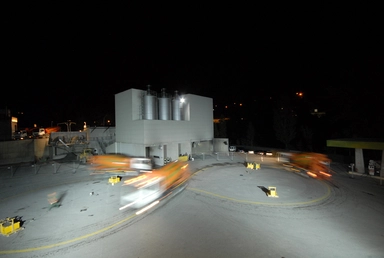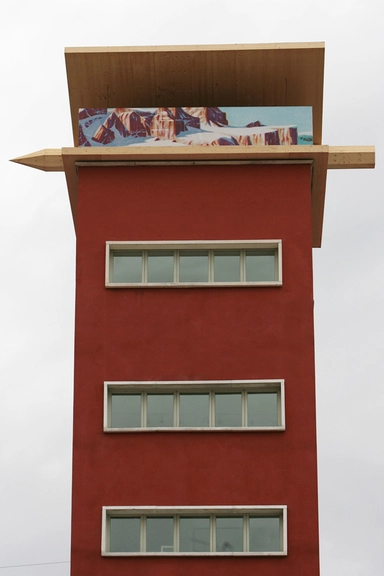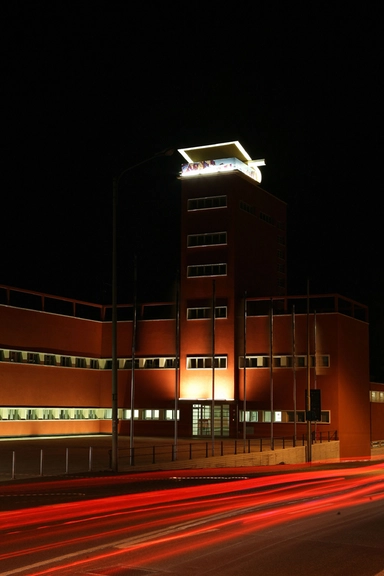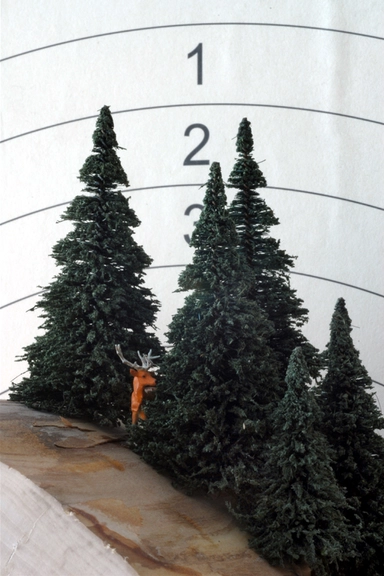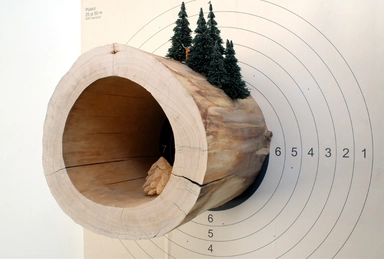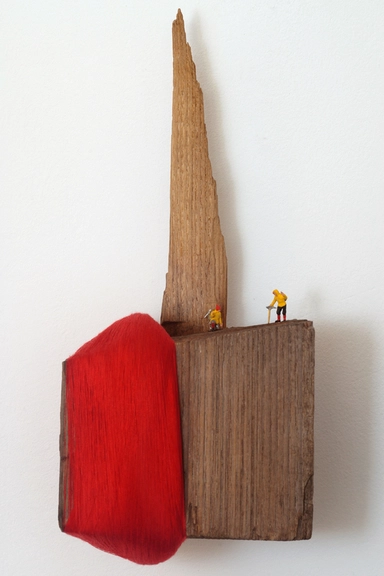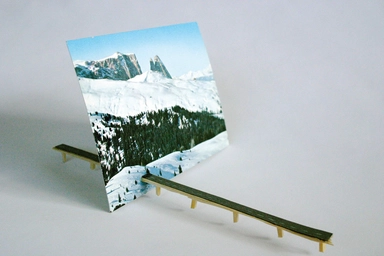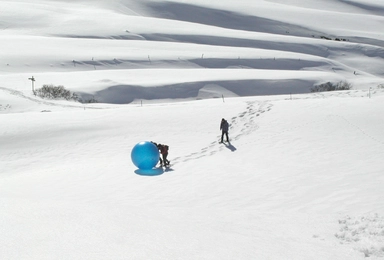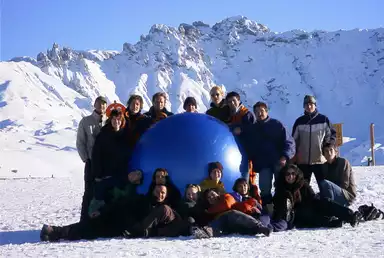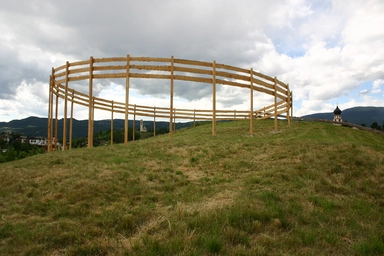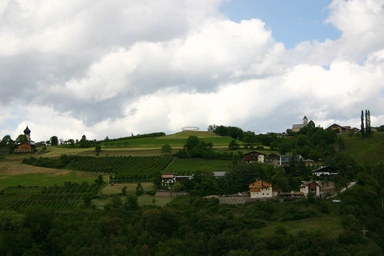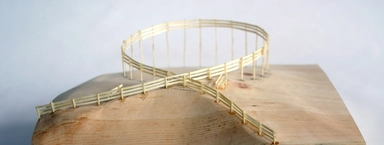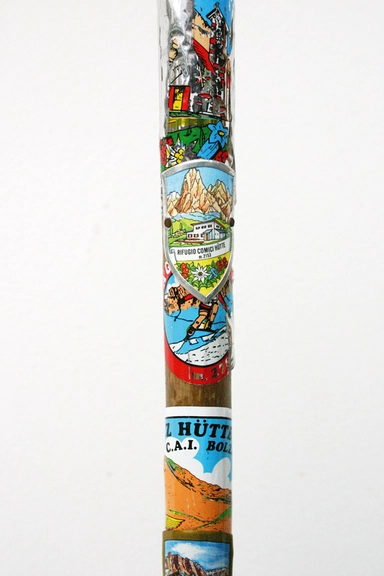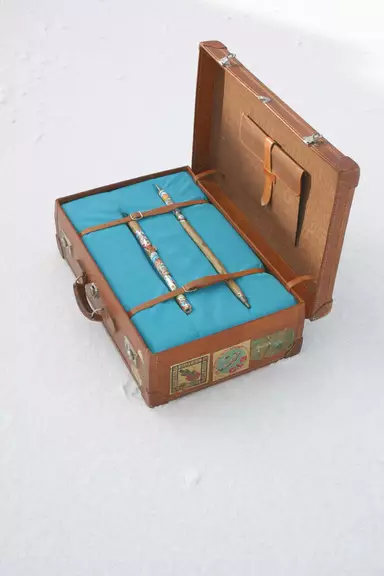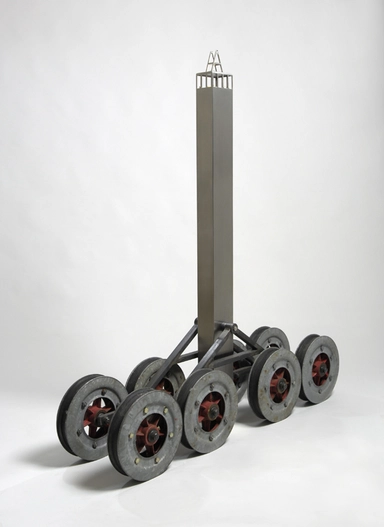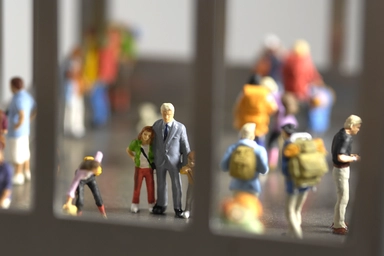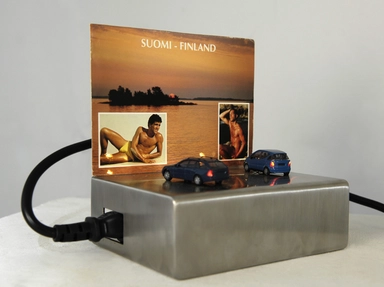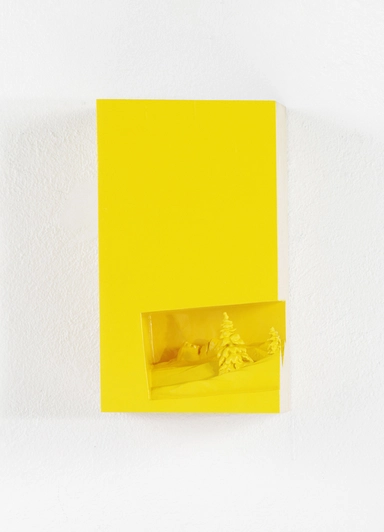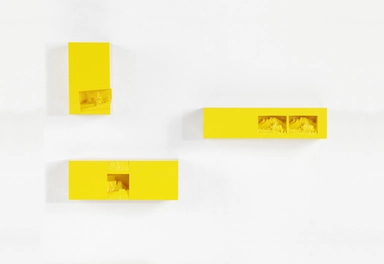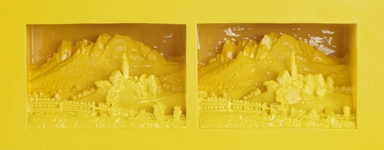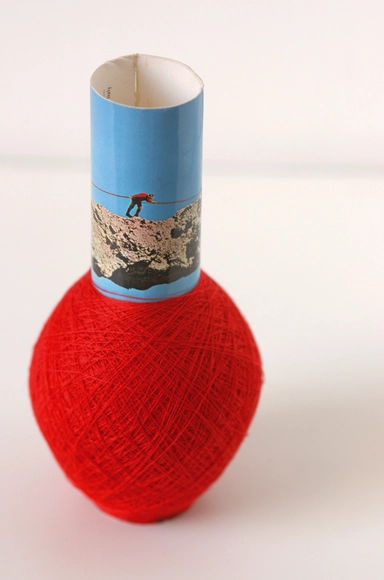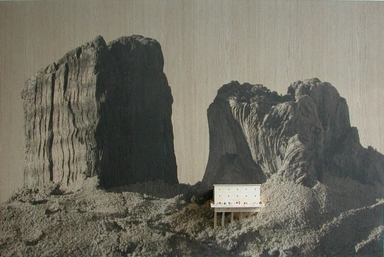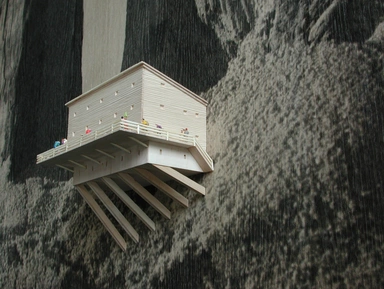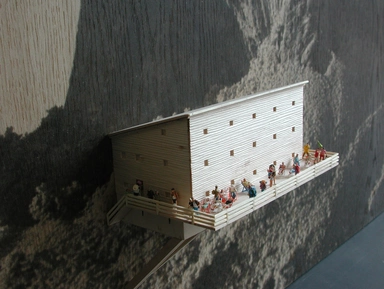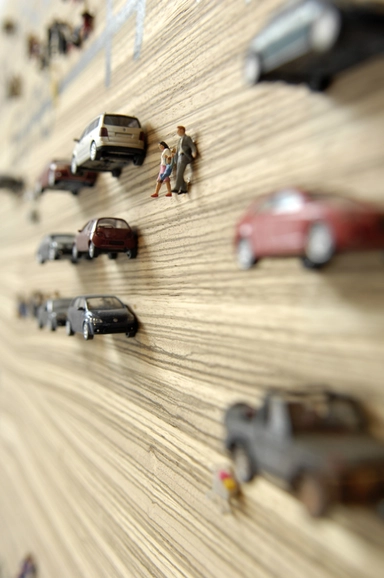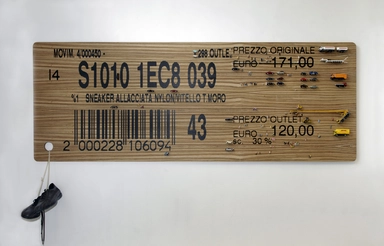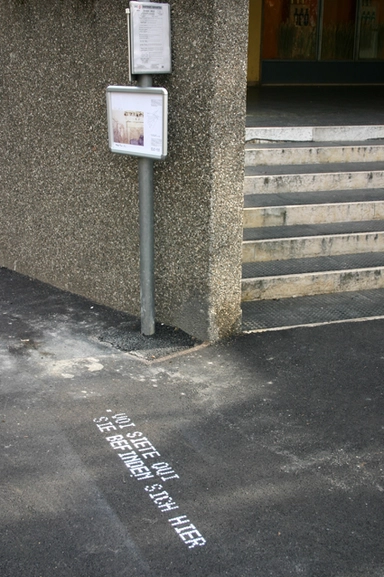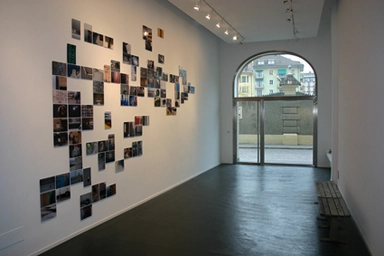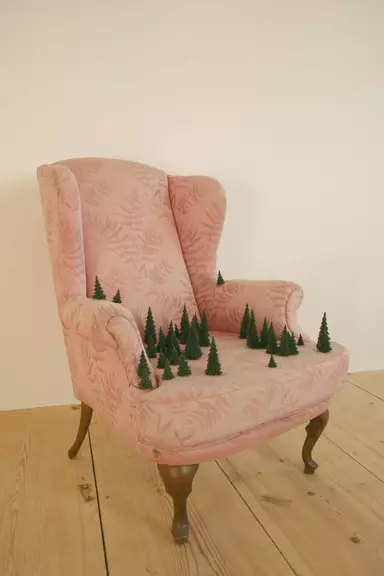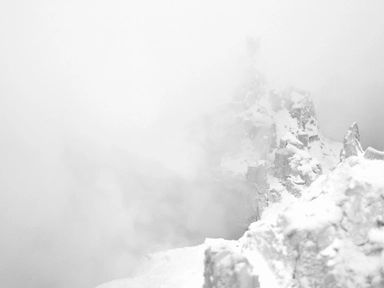LACORDA02, tublá da nives, 2025, various dimensions, mixed media
Fotos: Thomas Biasotto
Ein Teil der Seile des befreiten Sasmujels findet sich in der Ausstellung LACORDA02. Die Überreste am Boden des Stadels lassen an eine vergangene Zeit, an das eingebrachte Heu im Stadel denken. Diese Bodenplastik bildet das zentrale Element und im ureigenen Sinn auch das Ausgangsmaterial für die weiteren Skulpturen und Wandarbeiten.
Alcune delle corde utilizzate per Sasmujel sono esposte nella mostra LACORDA02. I frammenti installati sul pavimento del fienile evocano un'epoca passata, il fieno che veniva portato nel fienile. Questa installazione a pavimento, dinamica, costituisce l'elemento centrale della mostra, oltre a rappresentare anche il materiale di partenza per le altre sculture e opere esposte.
Lisa Trockner
Seilstücke, 2020-23, various dimensions, mixed media
Foto mitte: Gustav Willeit für Südtiroler Künstlerbung
Für die oft großformatigen Wandarbeiten werden Seile aufgerollt, aneinandergereiht, sortiert – Handgriffe, die durchaus den Praktiken des Alpinkletterns entlehnt sind. Auch hier baut Kostner bewusst eine Abart, entgegen dem dynamischen Charakter von Seilen, ein: den Nagel. Die Seile werden mit Nägeln, genauer gesagt mit verzinkten Dachpappnägeln, an die Bildträger angebracht. Damit wird, ähnlich wie bei den künstlichen Klettergriffen, durch einen Kontrapunkt, das ambivalente Verhältnis von Mensch und Natur unterstrichen.
Lisa Trockner
Seilstücke, 2020-22, various dimensions, mixed media
Foto rechts: Gustav Willeit für Südtiroler Künstlerbund
Aus den Seilstücken des Sasmujel entstehen seit 2021 kontinuierlich neue Arbeiten, die einzelnen Werke werden fortlaufend ihrer Entstehungszeit entsprechend nummeriert. In den skulpturalen Werken wird das Seil seiner flexiblen Beschaffenheit enthoben und entgegen der natürlichen Schwerkraft in statischen Positionen eingefroren. Hier kombiniert Kostner künstliche Klettergriffe, wie man sie aus Kletterhallen kennt, mit den Seilen.
Dal 2021, con i pezzi di corda del Sasmujel sono state create continuamente nuove opere, numerate consecutivamente in base al periodo in cui sono state prodotte. Nelle opere scultoree, la corda viene spogliata della sua natura flessibile e congelata in posizioni statiche, sfidando la naturale forza di gravità. Qui Kostner combina le prese artificiali dell'arrampicata, presenti nelle palestre di roccia, con le corde.
Lisa Trockner
plastik skulptur, 2018-20, various dimensions, mixed media
"plastik - skulptur" nennt Kostner diese Arbeiten. Der Künstler ist Plastiker und Bildhauer zugleich. Wird bei den abgewitterten Holzstämmen durch den Verwitterungsgsprozess in einem bildhauerischen Sinn Material weggenommen so sind die übergestülpten Plastikflaschen materialaufbauend, eine Plastik im doppelten Sinne im Material wie im Formungsprozess.
Günther Moschig
Wachsbilder, 2017-20, various dimensions, mixed media
Polychromos 74, 2019-21, 57x10x10 cm, Holz, Holzbuntstiftfarbe, Firnis mit UV-Schutz
Polychromos 74,87,46 (Höhe 54-60 cm), 2019-2021, Holz, Holzbuntstiftfarbe, Firnis mit UV-Schutz
Vor einigen Jahren habe ich mit dem Bearbeiten von fertigen Grödner Holzschnitzereien begonnen; durch das Abrichten an der Hobelmaschine abstrahiere ich diese Holzfiguren und Holzreliefs. Die entstehenden Flächen bemale ich mit Holzbuntstiften. Ein Firnis mit UV-Schutz konserviert die Werke, die sich nun Polychromos nennen. Eine Serie von 100 Werken ist so entstanden.
LUCI (im Rahmen von Angelus Loci), 2021, 270x650x40 cm, Fichtenbretter sägerauh, Gewindestangen, LED
Fotos: Valentina Casalini
Angelus Loci è un progetto curato da franzLAB in collaborazione con l’Azienda di Soggiorno e Turismo di Bolzano, su incarico della Città di Bolzano.
Le luci accendono la città a Natale, ma “luci” è anche una parola che, nella sua brevità, può contenere una miriade di messaggi: da sempre, nei riti cristiani come in quelli pagani e di altre culture al solstizio d’inverno, se ne celebra con l’allungarsi del giorno il ritorno, come simbolo di rinascita. Nell’opera di Hubert Kostner ogni lettera della parola L U C I illumina lo spazio urbano nel periodo natalizio, in un intervento artistico che riluce – come un angelo – nel segno di un’umanità illuminata e della convivenza pacifica.
Angelus Loci, kuratiert von franzLAB in Zusammenarbeit mit dem Verkehrsamt Bozen und im Auftrag der Stadt Bozen.
Sie erhellen besonders in dunkleren Monaten in mannigfaltiger Ausführung Plätze, Parks und Gassen. Immer schon waren Lichter bzw. Luci auf Italienisch für Menschen aller Kulturen überall auf der Welt von Bedeutung, sie feierten deren Rückkehr und auch Abwesenheit. Hubert Kostner erhellt mit seiner Lichtarbeit einen Ort in Bozen. In alle Himmelsrichtungen strahlt ein Wort – wie ein Engel – und steht für ein erleuchtetes Menschsein und ein friedvolles Zusammenleben.
Dolomitipunkt, 2019, 165x171x6 cm, mixed media
Foto mitte und rechts: Günter Richard Wett
Sasmujel (Im Rahmen von transart 19), 2019-2020, ortsspezifische Kunstinstallation mit 10.500 mt Kletterseil
Fotos: links und mitte Tiberio Sorvillo, rechts Janis Giovanett
Als der österreichische Alpinist Paul Grohmann, begleitet von zwei Bergführern, am 13. August 1869 den Langkofel erstbestieg, war dies eine Sensation. 150 Jahre später wird mit einem zeitgenössischen Kunst-, Musik- und Performanceprojekt an diesen Meilenstein der Alpingeschichte erinnert. Inmitten der atemraubenden Felsarena zwischen Langkofelkar und der Langkofelhütte auf 2.500 Meter Meereshöhe begegnen sich Musiker*innen, Bergsteiger*innen und Seilperformer*innen.
Der Künstler Hubert Kostner geht dem Begriff des „Gefesseltseins“ auf den Grund und fesselt einen gigantischen Felsblock mit Kletterseilen. Der Komponist Eduard Demetz spürt den akustischen Weiten der Gebirgslandschaft nach und verortet das gigantische Gesteinsmassiv mit 20 Bläsern. Die Choreographin Anastasia Kostner wird zwischen einheimischen Bergsteiger*innen und Performer*innen Energie und Bewegung in die akustisch-bildnerische Landschaft setzen.
La prima conquista del Sassolungo da parte di Paul Grohmann e due guide alpine il 13 agosto del 1869 fu un evento sensazionale. A 150 anni di distanza questa pietra miliare dell’alpinismo viene celebrata con un evento di arte, musica e performance all’insegna del contemporaneo. Nel mezzo dell’anfiteatro roccioso tra il vallone ed il Rifugio Vicenza, a 2500 metri sopra il livello del mare si incontreranno musicisti, scalatori e performer.
L’artista Hubert Kostner va a fondo del concetto dell’ “essere legato” e assicura un gigantesco masso con corde da arrampicata. Il compositore Eduard Demetz indaga la qualità acustica dei vasti spazi del paesaggio alpino collocando sul massiccio roccioso 20 strumentisti a fiato. La coreografa Anastasia Kostner animerà con la danza il paesaggio acustico e fisico in compagnia di scalatori e performer locali.
Artikel zum Projekt "Sasmujel" im Seiser Alm Magazin ALPE, Sommer 2020 // download pdf dt
Articolo sul progetto "Sasmujel" nella rivista ALPE, estate 2020 // download pdf it
Article about the project "Sasmujel" in ALPE magazine, summer 2020 // download pdf en
Sasmujel, der gefesselte Stein, 2021, 21:56 min. Link zum Film
TRUST, 2018, 2,80x15x0,025 mt, wood
let it snow, 2012-17, 95x90x50 cm, metal
Fotos: Ramona Waldner, ©Raiffeisen/Waldner
Montage, 2015-17 (4 Teile), 100x100x9 cm pro Teil, mixed media
Foto: Günter Wett
BAR, 2016, 118X201X62 cm, mixed media
Foto rechts: Günter Wett
Eiszeit, 2016, mit Arnold Holzknecht, 135x45x19 cm, gefrorenes Wasser, Lebensmittelfarbe, Holz
Video Eiszeit, 2016, 02:33 min
telefon di mác, 2016, 212x85x6 cm, phonetische Transkription von 28 Sprachaufnahmen, Zirbelkieferholz
Hubert Kostner, ispiré dala frasa de John F. Kennedy “Ich bin ein Berliner” dl ann 1963, analisëia te süa opera Telefon di Mac lingac sciöche lerch locala culturala. Al fej la traduziun dla conotaziun dl zitat tl ladin: “Ich bin ein Ladiner. Ich bin einer von Euch. (I sun n ladin. I sun un de Os)”. Sön so iade dal museum a so post nadé te Ciastel ti ál fat dí do a de plü porsones incuntades por caje, propi sciöche pro le jüch por mituns telefon di mac, la frasa de so predezessur. Vigni protagonist nü porta ite na coloraziun nöia che vëgn da so contest linguistich dialetal y müda insciö tres deplü l'espresciun. Fora dl grup che s'á incunté por caje vëgnel cherié n pool linguistich nü che an pó da öna na pert lí do te süa trascriziun fonetica, mo ince aldí pro la mostra. Kostner trasponn te na manira acorta y sensibla l'at de reconziliaziun de Kennedy analisan criticamënter le raiun cultural colié dal lingaz dl'identité ladina y de süa identité o, che, ci y olá é pa le ladin ancoré y ci fej pa fora chësc?
Inspiriert von John F. Kennedys Satz „Ich bin ein Berliner“ aus dem Jahr 1963, untersucht Hubert Kostner in seiner Arbeit Telefon di Mac Sprachen als kulturellen lokalen Raum. Er übersetzt das Zitat konnotativ ins Ladinische: “Ich bin ein Ladiner. Ich bin einer von Euch. (I sun n ladin. I sun un de Os) ”. Auf der Reise vom Museum zu seinem Heimatort Kastelruth hat Kostner wie im Kinderspiel „Stille Post“ den Satz des Vorgängers der jeweils zufällig getroffenen nächsten Person zum Nachsprechen vorgespielt. Jeder neue Protagonist bringt aus seinem Sprach- und Dialektumfeld eine neue Färbung mit ein und verändert damit die Aussage selbst zunehmend. Aus der zufälligen Zusammensetzung der Gruppe entsteht ein neuer Sprachpool, den man in der Ausstellung nicht nur hören, sondern auch in seiner phonetischen Transkription nachlesen kann. Die politische Versöhnungsgeste Kennedys, übersetzt Kostner subtil und sensibel in eine Hinterfragung des durch Sprache gebundenen Kulturraums der ladinischen und der eigenen Identität. Wo ist das Ladinische verankert und wer oder was macht es aus?
Ispirato da una frase del 1963 di John F. Kennedy, “Ich bin ein Berliner”, Hubert Kostner analizza nella sua opera, Telefon di Mac, le lingue come spazio culturale locale. Egli traduce le connotazioni della citazione in ladino: “Ich bin ein Ladiner. Io sono uno di voi. (I sun n ladin. I sun un de Os) ”. Durante il viaggio dal museo al suo paese natale di Castelrotto ha detto questa frase a una persona incontrata per caso che l’ha ripetuta a sua volta; la registrazione di quest’ultima è poi stata fatta ascoltare a un’altra persona che l’ha ripetuta a modo suo. E così via, come nel gioco d’infanzia del telefono senza fili. Ogni nuovo protagonista aggiunge una nuova coloritura proveniente dal proprio contesto lessicale e dialettale e in questo modo modifica sempre più l’asserzione iniziale. Da un gruppo di individui incontrati per caso si sviluppa così un nuovo pool linguistico che nella mostra è possibile leggere e anche ascoltare nella sua trascrizione fonetica. Il gesto politico di riconciliazione di Kennedy è tradotto da Kostner in modo sottile e sensibile in un’analisi critica dello spazio culturale ladino, definito da una lingua, e della propria identità: dove si ancora la ladinità e chi e cosa la contraddistingue?
Inspired by John F. Kennedy’s 1963 quote “Ich bin ein Berliner”, in which the president expressed that he was a person of Berlin, Hubert Kostner’s work Telefon di Mac studies languages as a local cultural sphere. He translates the bottom line of the quote into the Ladin language: “Ich bin ein Ladiner. I am one of you. (I sun n ladin. I sun un de Os)” Like in a game of Chinese whispers, he asked random people he met on his journey from the museum to his home town Kastelruth to repeat this sentence as it was said by the person before them and recorded by the artist. Each person joining the game brings in a totally new pitch and tonality typical of their language and dialect environment, thus gradually changing the sentence as the game goes on. An arbitrary group of passers-by thus forms a new language pool that you can listen to at the exhibition and check the phonetic transcription. Kostner subtly and sensitively translates Kennedy’s gesture of political reconciliation into a study of the cultural sphere of Ladin identity, and of one’s own personal identity, tied together by a common language, trying to answer questions as to where its roots are, and what is characteristic of the Ladin language.
Karin Pernegger
telefon di mác (Audio), 2016, 28 Sprachaufnahmen, 02:18 min
T 2015, 2015, diameter 22 Meter, mixed media
Auf den verkehrsintensivsten Kreisverkehrs Südtirols, Grutzen bei Bozen Süd, stellt Kostner seine neue Arbeit, eine riesige gelb leuchtende Torte. Die an Biskuit erinnernde Plattform mit einem Durchmesser von 22 Metern gratuliert einerseits der Firma Technoalpin zu ihrem Jubiläum. 25 Kerzen aus umgebauten Schneelanzen zeugen auf dem hölzernen Tortenboden vom festlichen Anlass. Andererseits ist die Torte auch der sprichwörtliche Kuchen, von dem wir alle in der Tourismusregion Südtirol naschen. Dabei haben wir Gedanken, die vor 30 Jahren noch als wahnwitzige Utopie galten, längst adaptiert und verinnerlicht. Der touristisch erschlossenen Winter ist ohne technische Schneeerzeugung nicht lebensfähig. Diese Realität verdichtet sich auf der Torte. Die als Tortenverzierung im Rautenmuster angebrachten Skisohlen transportieren die Berglandschaft ideell in eine neue Umgebung.
Sulla rotonda più trafficata del Sudtirolo, Agruzzo a Bolzano Sud, Kostner installa la sua nuova opera, una torta gigante di colore giallo brillante. La piattaforma del diametro di 22 metri, che ricorda il pan di Spagna, da un lato fa gli auguri all’azienda Technoalpin per il suo anniversario. 25 candele sul fondo torta di legno, formate da lance da neve modificate, sono il segno dell’evento festoso. D’altra parte, questa torta è anche il proverbiale dolce da cui tutti noi nella regione turistica del Sudtirolo pilucchiamo. In realtà, già da molto tempo abbiamo adattato e interiorizzato idee che ancora 30 anni fa erano considerati una folle utopia. L’inverno sfruttato turisticamente non può sopravvivere senza produzione di neve tecnica. Questa realtà si condensa sulla torta. Le suole degli sci, applicate a forma di rombo come decorazione di torta, trasportano il paesaggio alpino idealmente in un nuovo ambiente.
Spuren im Schnee, 2015, 100x50x3 cm, wood, Ski base, water-based paint
Konzeptmontage, 2013-2015, Museion Project Room 06.06.-30.08.2015
Fotos: Augustin Ochsenreiter ©Museion
Hubert Kostner has always been interested in the Alpine landscape, its traditions, its past and present. The project created for Museion's Project Room is an attempt to bring these elements, and more, into the exhibition space.
In terms of art history, Hubert Kostner draws inspiration from the wall drawings of Sol Lewitt, the American conceptual artist who revisited the Italian fresco tradition by creating a system of lines on the wall, marking out the space and forming the artistic equivalent of a musical score.
Kostner’s project also references mountain films, in particular those of Arnold Fanck, whose 1931 film Der Weisse Rausch (The White Ecstasy) brought footage of snow-covered mountains to the general public. The image of the Alps presented by the German filmmaker is strongly bound up with the figure of the skier, who traverses, inhabits and carves the white slopes with his skis. Kostner takes his own vision of the landscape into another space, boldly delineating and redefining the exhibition space, just as skiers do on the snow. Hubert Kostner’s installation, which is both a drawing and a trace, is a sort of metonym: it creates an image of the landscape by using the same elements it is made up of in real life. The tracks left on the slopes are rendered using the black bases of skis, while the depth of the landscape is evoked by including sections of steel ski lift cables. As in recent works, the artist reflects on the relationship between man and the environment from an ironic, critical perspective, using a practice based on the notions of “Cut” – a term he uses to sum up his latest pieces – and “Konzeptmontage,” meaning a montage of images, together with the title of the show.
Frida Carazzato and Letizia Ragaglia
Videointerview Konzeptmontage, Museion
Videobeitrag Konzeptmontage, Kulturzeit RAI Südtirol
Himmel, 2014, 10 teilig, ca. 200x200x12 cm, Holz, Lackfarbe
Quart Heft für Kultur Nr. 25/15, Hubert Kostner Originalbeilage . Haymon Verlag, Innsbruck-Wien. ISBN 978-3-7099-7201-4
Videobeitrag von Quart für Hubert Kostner, Originalbeilage
peccato originale, 2014-15, 180x70x70 cm, wood, iron
Frühjahrsputz, 2012-14, 50x14x14 cm, Holz, Postklebeband, Besenborsten, Lackfarbe
cut, 2014, soloshow
dios, 2014, 80x80x22 cm, wood
Friends, 2013-14, mit Felix Tschurtschenthaler, Videoinstallation.
Video Friends
?, 2013, 90x50 m, im Rahmen von smach
L’erba é gnüda siada incër la sagoma de n gran punt interogatif. Tl punt chersciarà l’erta tratan döt isté, y döt intoronn gnaràra siada jö aladô di ritms dla agricoltöra locala. Le laûr de Hubert Kostner se fej domandes - tres i mesi y l’usanza dl post - sön la natöra, l’ambiënt, l’agricoltöra, le turism y l’ert. Recorć, vijiuns y temporanité é i atri temesc che l’opera ô recordé.
L’erba è stata falciata intorno alla sagoma di un grosso punto interrogativo. L’erba all’interno del punto crescerà durante tutta l’estate, mentre tutt’intorno verrà falciata secondo i ritmi dell’agricoltura locale. Il lavoro di Hubert Kostner pone degli interrogativi sulla natura, sull’ambiente, sull’agricoltura, sul turismo e sull’arte, su ricordi, visioni, fugacità e temporaneità.
Das Gras im Fragezeichen kann einen ganzen Sommer lang blühen. Rundherum wird die Wiese im Rhythmus der vorherrschenden Landwirtschaft gemäht. Die Arbeit hinterfragt mit den Mitteln des Ortes wie wir mit der Natur, Kultur und dem Tourismus umgehen. Das Fragezeichen sollte auch auf die menschlichen Phänomene und Emotionen rund um Erinnerung, Vorstellung und Vergänglichkeit hindeuten.
The grass was mowed around the silhouette of a big question mark. The grass will grow inside the point throughout the summer, while all around is mowed according to the rhythms of local agriculture. The work of Hubert Kostner raises questions about the nature, the environment, agriculture, tourism, memories, visions, instability and seasonality.
agner, 2012, 100 m2 installazione, pietra, corda da arrampicata
Fotos: Giacomo de Doná
In collaborazione tra Dolomiti Contemporanee e la Galleria Goethe di Bolzano. Il progetto ideato da Kostner prevede la realizzazione di un'installazione che ha per tema e soggetto lo Spigolo Nord del Monte Agner (2871 m.s.l.d.m.), una parete classica, con i suoi 1.600 metri, una delle più alte delle Alpi. La parete fu scalata per la prima volta nel 1921 da Iori, Andreoletti e Zanutti. La prima ascensione invernale fu realizzata nel 1968 da Messner e Mayerl. Kostner vuole riprendere quest'ascensione, lavorando sullo Spigolo Nord dell'Agner. L'idea è quella di realizzare un'installazione utilizzando 1.600 metri di corda da arrampicata, per ricavarne un oggetto artistico compatto, che sarà allestito in uno degli spazi di mostra. L'opera costituisce quindi una riflessione sull'alpinismo, sull'arrampicata, sull'idea generale di “via” alpinistica, in rapporto ad un itinerario artistico: entrambe le vie, quella dell'alpinista, come quella dell'artista, sono percorsi di ricerca, e come tali, accomunati da una volontà di esplorazione verticale.
Gianluca D'Incà Levis
barth, wine box edition 2012, with Sandy Attia, Matteo Scagnol,
2012, 35x25x15 cm, painted resin bag. // more
Fotos: Jürgen Eheim
alles wird gut, in Zusammenarbeit mit m10, 2012, 140x80x0,5 cm, Papier und Kleister
ornament3 (Künstlerische Gestaltung der Bergstation Rittner Seibahn Seibahn), 2011, 500x2000 cm, Brandschutzfarbe auf Heraklitplatten
Die neue Rittner Seilbahn ermöglicht durch ihre moderne Technologie, noch schneller als bisher von der Stadt in eine ganz andere Atmosphäre, die des Berges, zu gelangen.
An den glänzenden Gondeln der Seilbahn haftet noch deutlich der urbane Charakter, der sich von der Talstation bis zur Bergstation durchzieht. Dann setzt das Erlebnis der Landschaft ein. Fahrgäste, die tagein tagaus oder vielleicht auch nur einmalig dieses Transportmittel benützen, erleben diesen Übergang von der einen zur anderen Dimension innerhalb weniger Minuten. Bei diesem Übergang wurde mit der Auswahl eines Kunstwerks von Hubert Kostner angesetzt, um eine kreative Auseinandersetzung mit dieser zweifachen Wahrnehmung zu ermöglichen.
Im Gegensatz zur Stadt stellt sich am Berg oft ein Gefühl der Freiheit ein. Das Erlebnis des Berges und seine Landschaft unterliegt dabei vielen Veränderungen. Viel hängt von den Jahreszeiten ab, aber auch vom Zufall: von den fortwährenden Veränderungen von Licht und Schatten, von Wind und Wolken. Am Berg lassen wir den Gedanken gerne freien Lauf.
Diese Befindlichkeit persönlicher Freiheit (und Interpretationsfreiheit) finden wir in der Wandmalerei Hubert Kostners wieder. Das Werkes arbeitet bewusst mit Zufallsprinzip und Spiegelung. Wie man in einem Bergprofil und in den Wolken Gestalten und Dinge sehen kann, so kann man in der abstrakten Malerei ein Geweih oder ein im Wind sich bewegendes Objekt erkennen.
Die Spiegelung bezieht sich nicht nur auf die Uneindeutigkeit der Wahrnehmung, sondern auch ganz konkret auf das doppelte Wesen der Seilbahn: sie füllt sich und entlädt sich, sie pendelt zwischen Berg und Tal, zwischen Natur und Stadt. Das von Kostner verwendete Schwarz stellt die neutrale Ausgangsbasis für immer neue emotionale Erlebnisse dar.
Letizia Ragaglia
summit book2, in Zusammenarbeit mit Quart, 2011, 30x42x5 cm, mixed media
pasta asciutta, 2011, 105x100x100 cm, mixed media
Pronto (with Manuela Kerer), 2009-2011, 50x40x20 cm, telphone set, cd player
Fotos: Dejan Habicht
Kostner presents a project created in close collaboration with the composer Manuela Kerer that treats the topic of technological development and the urban environment.
Pronto uses a simple, everyday object for its artistic formation and, through sound intervention, evokes a current of the subconscious in the viewer - memories of communicating with the world, one's homeland, "all the little things", telephone cards, and so on. And it is here that the author's topicality lies: the questioning and even ironic warning about the pace of technological development and the tempo of life.
With unassuming surprise, the project cautions and speaks to viewers even as it sets them before a dilemma: Are they prepared, in the bustle of urban life, to listen to and follow a fragment of art, even if this is an entirely random event?
Pronto (Audio), Manuela Kerer, 2011, 04:01 min
rip, 2011, 132x71x74 cm, wood, nickel plated iron, elements from model making
Fotos: Johannes Plattner
kochmaschine, 2009-2011, 70x20x20 cm, hotplate with chain, nickel plated
Fotos: Johannes Plattner
Foto: Franco Coccagna
Foto: Leo Angerer
Turbo Lenz, 2010, in Zusammenarbeit mit dem Südtiroler Künstlerbund, Aktion mit Felix Tschurtschenthaler, helicopter, grass seed
Foto: webcam Plose
Hausglocke FROM&T(W)O, in collaboration with kunstmeranoarte, 2010, Installation, with Michael Sailstorfer, bell diameter 40 cm, bell height 28 cm, rope length variabel, melted bronze, wood, metal, rope
Fotos: Ivo Corrá
Fotos: Leo Angerer
One Night II, 2010, artsession Südtiroler Künstlerbund at Hotel Jarolim, Brixen (I)
oil painting, 2008-2010, diameter 38 cm, size 60 cm, metal, oil paint
Randerscheinung, 2010, 58x94x86 cm, top-opening freezer, snow, urine
Fotos: Leo Angerer
Milchstrasse, Wiener Festwochen 2010, 1600x9000 cm, white dispersion paint on asphalt street
Fotos: Judith Kaltenböck
white mountains, dead valleys, 2009, 200x600x2,5 cm, wood, hinge joints
Colouring, 2009-2010, 66,5x49x1 cm, metal, varnish paint on pin-up calendar
colouring vehicles, 2009-2010, 50x32x0,5 cm, metal, car finish, erotic calendar
colouring vehicles, 2009-2010, 40x32x0,5 cm, metal, car finish, erotic calendar
Magazin 109, 2009-2010, 24x16,5x2 cm, MDF, varnish paint on erotic magazin
Lost&Found, 2007-2008, 400x200x100 cm, mixed media
(VAF-Stiftung, Mart)
saturday night fever, 2008, 200x120x60 cm, mixed media
Greenhouse, 2008-2009, 36 m² installation at Museion Bolzano, Atelierhaus, 20 m³ expanded clay, wood, infrared light
Fotos: Ivo Corrá
sudator, 2008, installation stazione fs bolzano, bahnhof bozen
video sudator, 2008, 02:33 min
egon, 2007-08, 10x6x4 cm, mixed media
an der bahn, 2008, 170x120x50 cm, mixed media
welcome on board, 2004-08, 500x265x265 cm, mixed media
Msuite, 2008, 160 m2 installation
/msuite/
Landratte, 2003-2008, 150x90x50 cm (box), wood
∞ for 5 concrete mixers, transart07, performance with Andreas Zingerle
summit book, eurac tower, 2007, 458x750x210 cm, wood, pvc print
Foto rechts: Oliver Oppitz
santo subito, 2004-2007, 62x53x53 cm, wood, plastic, glass
Hubertustreffen, 2004-2006, 57x54x27 cm, mixed media
Strudel, 2006, 34x15x12 cm, mixed media
bbt, 2005, 15x10x21 cm, cardboard, wood
blauer ball, 2002, performance
video blauer ball, 2002, 04:16 min
giro, 2006, 1600x600 cm, wood
hans hat glück, 2006, 65x45x20 cm, mixed media
Accessoire, 2006-2007, 155x135x36 cm, iron, plastic
Autokino, 2007, 15x15x12 cm, iron, postcard
p.p.36,37,38, 2008-11, various dimensions, mixed media
Fotos: Günter Kresser
das ehepaar demetz, 2006, 15x7,5x7,5 cm, postcard and thread
principe, 1998-2005, 120x180x25 cm, wood, plastic
Pixie, 2005-2006, 220x80x5 cm, mixed media
rtu_ms bozen, 2004, art in public space / exhibition
scéne d' amour, 2006, 110x80x80 cm, mixed media
tyrol, 2007, various dimensions (height 80-100 cm), wood, plastic
welcome on board, 2004, 60x80 cm, photo on dibond
